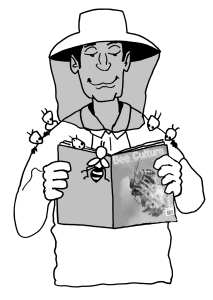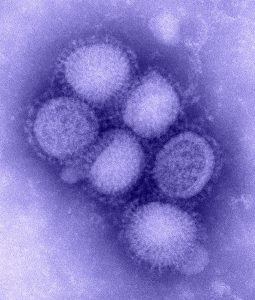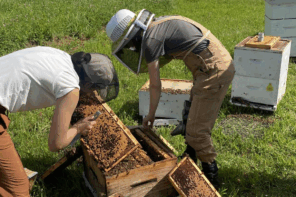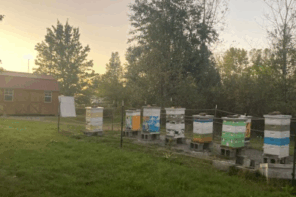 From the Editor, Jerry Hayes
From the Editor, Jerry Hayes
Virus
QUESTION
All I hear about are the viruses found in honey bees and how they are hurting or killing them. I never hear about how to control viruses in honey bees. Little masks and vaccines?
Maurice Boudreau
ANSWER
You sound frustrated. And you should be. Honey bees have evolved through time without developing a robust immune system in an individual bee. They were short lived and the resources needed to support a vigorous immune system were not energy efficient. So, the individual honey bee has an immune system but it is the whole colony which has a more comprehensive immune system. Think of a honey bee colony as one organism and the individual bee as a cell in that organism. Cell(s) can be sacrificed individually just like in our bodies until the disease is contained. Remember back in the day when Colony Collapse Disorder (CCD) was in the headlines? Colonies lost population and eventually the hive was mostly empty. I am going to anthropormorphize (give human traits) to honey bees now. That was because individual workers who ‘felt sick’ left the colony because they ‘know’ that they might make their sisters sick. They leave the colony and don’t return. They do honey bee suicide to protect their sisters and the colony from whatever they may have disease wise. In CCD, the colony dwindles as individual bees leave and do not return. If thousands of bees feel ‘sick,’ they make this ‘individual decision’ to leave and after some time there are no bees left in the colony. Voila, CCD.
 Over time, researchers determined that the virus load from Varroa parasitism was 20-30 mites per hundred bees and the viruses Varroa transmit to infect honey bees and make them ‘sick’ was the CCD mechanism. And another voila, the Varroa Virus Legacy.
Over time, researchers determined that the virus load from Varroa parasitism was 20-30 mites per hundred bees and the viruses Varroa transmit to infect honey bees and make them ‘sick’ was the CCD mechanism. And another voila, the Varroa Virus Legacy.
Currently, there are lots of research projects to see if the honey bee immune system can be enhanced or supported to remove these viruses and their negative health effects. But, nothing yet. Stay tuned.
Hygienic Bees
QUESTION
Please explain what capping and re-capping is. Hygienic bees are supposed to be doing it for Varroa control.
Devin Schloksky
ANSWER
The Varroa destructor parasite of honey bees is something our European genetically evolved honey bees didn’t have to deal with and adapt to. But with global connections to everywhere most all pests, parasites and diseases are on the next international or national flight. Remember COVID?
Life finds a way and our survivor honey bees and fantastic honey bee breeders have identified a trait of survivor bees that can potentially be enhanced as part of IPM strategy to deal with Varroa. These bees can recognize an odor, a pheromone, emitted from a cell containing a developing bee that sometimes indicates that a Varroa foundress mite is in the cell. The bees with this genetic trait will uncap the cell with this odor. The uncapping disrupts the mites reproductive and offspring development and can, of course, then lower Varroa mite density in the colony. But, like everything else biologically, this is not a perfect system. Sometime the cells uncapped do not have mites in them and sometimes cells with mites are not uncapped. Soooo, at this moment in time this trait in bees can be part of a ‘system approach’ to Varroa control, as it is not a ‘silver bullet’ by itself.
SWIMMING POOLS
QUESTION
Is there any truth to the concern that colonies should not be placed within certain distances of swimming pools since if/when a colony swarms, the mass of bees may attempt to access the water, and could represent a hazard to swimmers?
Robert Marley
ANSWER
No.
Short story is honey bees need water for biological reasons and for evaporative cooling of a beehive in hot weather.
Just like pollen or nectar foragers there can be water foragers.
Being able to share any of these with their sisters with taste and odor and direction to this identifiable taste and odor is very important. They have to be able to find it.
If honey bee water foragers are offered distilled water outside of the hive and they get a sample, take it back to the colony and share it with other foragers they hope to recruit, these potential recruits have no idea what this is as it has no taste or odor. Kind of like you with a cold, you can’t taste or smell anything. Those cookies are not that attractive even though you can see them sitting on the kitchen counter.
Treated swimming pool water has lots of minerals in it. So it has lots of taste and an odor profile. The sample of this is easy to share with foragers in the colony along with direction and location where it can be found.
Swarms are the reproductive stage of a honey bee colony. They are not food or water foragers. They are looking for a cavity to nest in, not take a swim.
NOSEMA CERANAE
QUESTION
Please advise the latest treatment for Nosema ceranae or direct me to the appropriate source?
Blessings,
Richard J. Woodham
ANSWER
The only known reliable treatment for Nosema apis in honey bees is the antibiotic fumagillin, which is derived from Aspergillus fumigatus and has been widely used to treat colonies infected with N. apis since the 1950s. It is labeled and sold as Fumidil-B usually from most large beekeeping distributors. It may not work as well on N. cerana. But, there is not a lot of data on alternative products that show control consistency. Pluses and minuses of course, with fumagillin with collateral damage to the honey bee herself. Kind of like all the commercials on TV for pharmaceutical products showing all the smiling people and then there is the small print at the bottom saying all the terrible things that might happen to you if you take it.
There are other products advertised that may or may not be appropriately approved and labeled that may have some impact. Welcome to managed beekeeping.
Apps for Beekeepers
QUESTION
Has there been any reviews by Bee Culture on the various apps for record keeping? If yes, then I would be interested in reading that article.
I have spent too much time downloading, testing then deleting apps.
Hope you can help or point me in the right direction.
Thanks,
Glen
ANSWER
No, we have not had a review of apps simply because of what you offer in your email.
But this would be a great question for the ‘Study Hall’ in Bee Culture to ask readers.
Okay beekeepers, what app do you use or not? Let me know your experience at Jerry@BeeCulture.com!
Salt water for bees
QUESTION
Would a very weak solution of water and Utah sea salt (no modern pollution) in a dish with a screen under a stone, to prevent drowning, be worth a try?
ANSWER
We all need to replenish salt and minerals in our human bodies daily especially in Summer when we sweat through all of our clothes underneath our bee suit.
Honey bees don’t sweat but they do need some minerals individually and for sharing with their sisters for biological metabolic efficiency.
What you are ultimately talking about is making a small treated swimming pool. Honey bees are attracted to treated swimming pool water because of the minerals and taste and odor profile to share with their sisters. For fun, you can put a sample out for them and if they need it and/or like it, they will come. If they don’t then you will know it didn’t meet their needs, wants or desires. Let me know how it works out. Take some pictures.
Mite Washes
QUESTION
I am not averse to doing mite washes, but I argue that for any apiary above a modest size, the resulting information provides no decision support.
Why? (1) For any given hive, there is a baseline probability that the hive is infested with Varroa. (2) If any hive in the apiary is infested, the whole apiary should be treated. The management decision then is just a probability calculation irrespective of what a mite wash would provide.
If the baseline probability of a single hive being infested is 10% (Randy Oliver’s estimate, for example), then even for an apiary of six hives the probability that at least one hive is infested is 50% and the whole apiary should be treated on probability grounds alone.
If your personal degree of risk aversion is to not tolerate an apiary chance of 50% but rather only 20%, then you would treat an apiary of three hives.
Mite washes are of genuine value if you are selectively breeding, but not if you deciding whether to put on this or that treatment.
We can now argue whether points (1) and (2) are correct as the rest follows from them.
Dan Geer
Tennessee/Alabama line
ANSWER
https://honeybeehealthcoalition.org/ Have you ever read the Tools for Varroa Management Guide or looked at the videos from the Honey Bee Health Coalition?
The reason this was compiled and written is because without sampling, treating if Varroa levels require, and then sampling after treatment to see if the treatment actually worked is because Varroa counts vary throughout the seasons. If you do not sample in Spring, or Summer or Fall especially when counts are rising, then your location in Tennessee / Alabama and Varroa counts will be much different than in Maine, Washington, North Dakota, Missouri etc., etc. It is a big country with lots of seasonal weather variation. And with climate change, weather is all over the board.
We have 30-40% losses every year as documented by BIP. Maybe if there were more beekeepers following the ‘Tools for Varroa Management Guide,’ losses would be less and Varroa Bombs much more infrequent.
We need Beekeepers not Beehavers.









